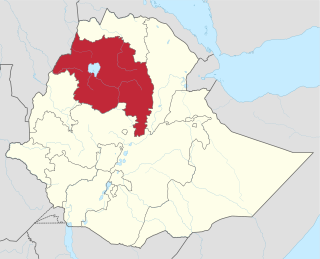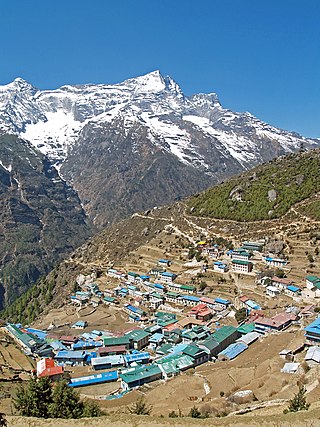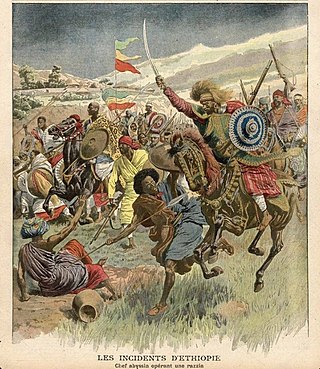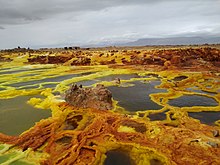
Cultural tourism is a type of tourism in which the visitor's essential motivation is to learn, discover, experience and consume the cultural attractions and products offered by a tourist destination. These attractions and products relate to the intellectual, spiritual, and emotional features of a society that encompasses arts and architecture, historical and cultural heritage, culinary heritage, literature, music, creative industries as well as the living cultures with their lifestyles, value systems, beliefs and traditions.

Lalibela is a town in the Amhara Region of Ethiopia. Located in the Lasta district and North Wollo Zone, it is a tourist site for its famous rock-cut monolithic churches designed in contrast to the earlier monolithic churches in Ethiopia. The whole of Lalibela is a large and important site for the antiquity, medieval, and post-medieval civilization of Ethiopia. To Christians, Lalibela is one of Ethiopia's holiest cities, and a center of pilgrimage.

Harar, known historically by the indigenous as Harar-Gey or simply Gey, is a walled city in eastern Ethiopia. It is also known in Arabic as the City of Saints.

Islam is the second-largest religion in Ethiopia behind Christianity, with 31.3 to 35.9 percent of the total population of around 113.5 million people professing the religion as of 2022.

The Amhara Region, officially the Amhara National Regional State, is a regional state in northern Ethiopia and the homeland of the Amhara, Awi, Xamir, Argoba, and Qemant people. Its capital is Bahir Dar which is the seat of the Regional Government of Amhara. Amhara is the site of the largest inland body of water in Ethiopia, Lake Tana, and Semien Mountains National Park. Amhara is bordered by Sudan to the west and northwest and by other the regions of Ethiopia: Tigray to the north, Afar to the east, Benishangul-Gumuz to the west and southwest, and Oromia to the south. Towns and cities in Amhara include: Bahir Dar, Dessie, Gonder, Debre Birhan, Debre Tabor, Kombolcha, Weldiya, Debre Markos, Seqota, Kobo, and Metema.

The Fasil Ghebbi is a fortress located in Gondar, Amhara Region, Ethiopia. It was founded in the 17th century by Emperor Fasilides and was the home of Ethiopian emperors. Its unique architecture shows diverse influences including Hindu, Arab, and Jesuit Baroque characteristics. Because of its historical importance and architecture, the fortress was inscribed as a UNESCO World Heritage Site in 1979. Ghebbi is an Amharic word for a compound or enclosure.

Tourism is the largest industry in Nepal and its largest source of foreign exchange and revenue. Home to eight of the ten highest mountains in the world, Nepal is a destination for mountaineers, rock climbers and adventure seekers. The Hindu and Buddhist heritage of Nepal and its cool weather are also strong attractions.

Ethiopia is a landlocked sovereign country located in the Horn of Africa. Ethiopia is bordered by Eritrea to the north, Sudan to the west, South Sudan to the south-west, Kenya to the south, Somalia to the east and Djibouti to the north-east. Ethiopia is one of the oldest countries in the world and Africa's second-most populous nation. Ethiopia has yielded some of humanity's oldest traces, making the area important in the history of human evolution. Recent studies claim that the vicinity of present-day Addis Ababa was the point from which human beings migrated around the world. Ethiopian dynastic history traditionally began with the reign of Emperor Menelik I in 1000 BC. The roots of the Ethiopian state are similarly deep, dating with unbroken continuity to at least the Aksumite Empire and its predecessor state, D`mt. After a period of decentralized power in the 18th and early 19th centuries known as the Zemene Mesafint, the country was reunited in 1855 by Kassa Hailu, who became Emperor Tewodros II, beginning Ethiopia's modern history. Ethiopia's borders underwent significant territorial expansion to its modern borders for the rest of the century, especially by Emperor Menelik II and Ras Gobena, culminating in its victory over the Italians at the Battle of Adwa in 1896 with the military leadership of Ras Makonnen, and ensuring its sovereignty and freedom from colonization. It was occupied by Benito Mussolini's Fascist Italy from 1936 to 1941, ending with its liberation by British Empire and Ethiopian Patriot forces. Its eastern border also changed in 1950 from the former 1908 Convention Line to the subsequent provisional administrative line.

The architecture of Ethiopia varies greatly from region to region. Over the years, it has incorporated various architectural styles and techniques.

Tourism in Costa Rica has been one of the fastest growing economic sectors of the country and by 1995 became the largest foreign exchange earner. Since 1999, tourism has earned more foreign exchange than bananas, pineapples and coffee exports combined. The tourism boom began in 1987, with the number of visitors up from 329,000 in 1988, through 1.03 million in 1999, over 2 million in 2008, to a historical record of 2.66 million foreign visitors in 2015. In 2012, tourism contributed with 12.5% of the country's GDP and it was responsible for 11.7% of direct and indirect employment. In 2009, tourism attracted 17% of foreign direct investment inflows, and 13% in average between 2000 and 2009. In 2010, the tourism industry was responsible for 21.2% of foreign exchange generated by all exports. According to a 2007 report by ECLAC, tourism contributed to a reduction in poverty of 3% in the country.

Tourism in Burundi refers to tourism in Burundi. Bujumbura, the largest city and former capital of Burundi, is a major tourist attraction of the country. In addition to this, Lake Tanganyika is a popular tourist attraction.

Tourism in Morocco is well developed, maintaining a strong tourist industry focused on the country's coast, culture, and history. The Moroccan government created a Ministry of Tourism in 1985. Tourism is considered one of the main foreign exchange sources in Morocco and since 2013 it had the highest number of arrivals out of the countries in Africa. In 2018, 12.3 million tourists were reported to have visited Morocco.
Ethiopian Greeks, or Greeks in Ethiopia, are ethnic Greeks from Ethiopia. Today they number about 500 persons and can be traced back to ancient times. They are mainly located in the capital, Addis Ababa, and the city of Dire Dawa.

The Ministry of Culture and Tourism is the Ethiopian government department responsible for researching, preserving, developing, and promoting the culture and tourist attractions of Ethiopia and its peoples, both inside the country and internationally. In doing so the Ministry closely works together with different national and international stakeholders.
Mohamouda Ahmed Gaas is an Ethiopian politician and a member of the Ethiopian ruling party. He was a State (Vice) Minister of the Ethiopian Ministry of Culture and Tourism up until October 2010, when he was later moved to Ministry of Science and Technology as a deputy Minister. Mohamouda Ahmed Gaas founded the Afar Revolutionary Democratic Unity Union (ARDUU) in 1991. ARDUU later became a part of the Afar Revolutionary Democratic Unity Front (ARDUF).

Jamia Mosque , also known as Grand mosque of Harar is a mosque in Harar, a city in eastern Ethiopia. It is located in the old walled city, the Harar Jugol, which is a UNESCO World Heritage Site.

Menelik's conquests, also known as the Agar Maqnat, were a series of wars and conquests carried out by Menelik II of Shewa to expand the Ethiopian Empire.

Ethiopia's industrial sectors classified into four basic groups: agriculture, food processing, construction, resources and energy and tourism. Agriculture constitutes over 50% of economic sector in Ethiopia, and the largest dependable economic activity. It includes production of livestock products, beverages, leather and textiles industry. Besides, Ethiopia is the largest exporter of coffee involving over 15 million active workers.

















